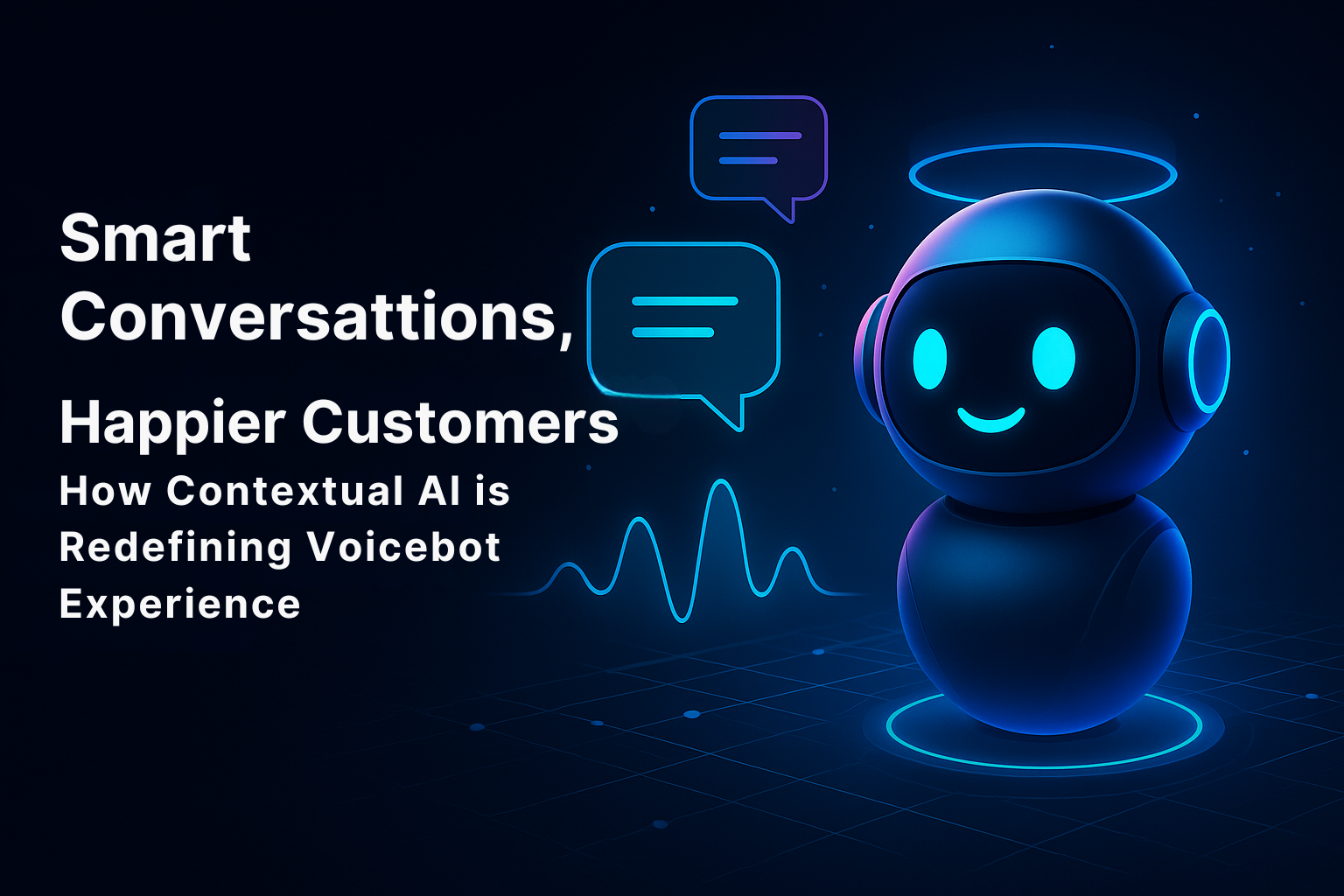
In the age of instant gratification, customers expect brands to understand them—quickly, personally, and without repetition. The rise of AI-powered voicebots has ushered in a new era of customer experience (CX), but it’s contextual AI that’s truly changing the game. Unlike traditional bots that follow rigid scripts, contextual voicebots adapt dynamically to conversations, recall user history, and tailor interactions in real time.
Welcome to the era where voicebots don’t just hear — they understand.
1. Introduction to Contextual AI in Voicebots
Voicebots are no longer just robotic responders reading from a script. Today’s smart voicebots are powered by contextual AI, enabling them to understand not just what is said, but why, when, and how. This deep understanding transforms the customer journey from a transactional interaction into a meaningful conversation.
2. The Evolution of Voicebots in CX
-
Operated on rule-based logic
-
Failed to handle nuanced queries
-
Required multiple handovers to human agents
-
Understand tone, sentiment, and conversation history
-
Respond naturally across various channels
-
Reduce friction and frustration for customers
This evolution marks a significant milestone in how businesses interact with users, especially in high-volume environments like contact centers, banks, retail, and healthcare.
Contextual AI refers to the integration of machine learning, natural language understanding (NLU), conversation memory, and user intent modeling to provide responses based on real-time context and historical data.
Key Elements:
-
Situational Awareness: Understanding current user environment and actions.
-
Conversational Memory: Retaining previous dialogue and preferences.
-
Intent Recognition: Identifying what the user really wants.
-
Adaptive Responses: Dynamically adjusting replies to fit the situation.
Rather than treating each interaction in isolation, contextual AI connects the dots across time, channels, and customer journeys.
Several advanced technologies converge to create a high-performing contextual voicebot:
a. Natural Language Processing (NLP)
Allows the bot to understand and interpret human language, including slang, emotions, and ambiguities.
Learns from historical data and continuously improves interactions and outcomes.
Helps the bot understand relationships between entities, improving its contextual intelligence.
Accurately converts spoken words into text in real time.
Determines emotional tone to guide conversation flow accordingly.
These technologies work together to create a voicebot that isn’t just reactive — it’s proactive, intelligent, and customer-centric.
5. How Contextual AI Enhances Voicebot Intelligence
Contextual AI gives voicebots the power to:
-
Remember previous conversations
E.g., “As you mentioned yesterday…” -
Adjust to user mood or urgency
E.g., Calm tone if customer is angry. -
Provide tailored recommendations
E.g., “Based on your recent purchases…” -
Handle multi-turn conversations
Following a user across several topics in a single session. -
Seamlessly transfer to human agents with context intact
No need to “start from scratch” when escalated.
This ability to personalize and predict user needs drives satisfaction, loyalty, and operational efficiency.
6. The Real Impact on Customer Experience
Contextual voicebots eliminate repetitive steps. No more “Can you repeat your account number?”
Bots understand intent quicker and respond with precision, leading to shorter call durations.
By analyzing sentiment, bots can escalate urgent issues or offer empathy in sensitive moments.
Customers enjoy the same intelligent experience — regardless of time, location, or agent availability.
Start a conversation via voice, continue on WhatsApp or chat, and the bot remembers everything.
All these enhancements lead to higher Net Promoter Scores (NPS), better CSAT scores, and stronger customer retention.
7. Use Cases Across Industries
-
Loan status updates
-
KYC documentation reminders
-
Fraud detection conversations
-
Appointment scheduling
-
Prescription reminders
-
Patient feedback collection
-
Order tracking
-
Product recommendations
-
Returns and refunds
-
Flight rebooking
-
Hotel check-in assistance
-
Loyalty point queries
-
Plan upgrades
-
Network issue resolution
-
Bill payment reminders
Every industry benefits from reduced friction and increased satisfaction through context-aware interactions.
8. Benefits for Businesses and Contact Centers
Automation of up to 80% of repetitive queries means fewer support agents needed.
Context-aware bots reduce time spent retrieving information.
Every customer receives the same level of intelligent service.
4. Data-Driven Insights
Voicebot interactions provide rich data for improving products and services.
5. Scalability
Easily handle seasonal or campaign spikes without compromising service quality.
The ROI is not just in cost savings, but in brand differentiation and customer loyalty.
9. Real-World Success Stories
Implemented contextual voicebots to reduce return-related call volume. Result? 32% reduction in agent workload, 18% increase in CSAT.
Used voicebots for KYC verification and reminders. Reduced drop-off rate by 40%.
Enabled multilingual contextual voice support. Increased NPS by 15 points in under six months.
These examples showcase the transformative power of contextual AI in real-world CX strategies.
10. Implementation Tips and Best Practices
-
Start with high-volume use cases (like FAQs or order tracking)
-
Integrate with your CRM and customer data platforms
-
Train voicebots with real customer interactions
-
Design for escalation — always provide human fallback
-
Monitor performance with analytics and iterate often
-
Don’t overlook the voice tone and persona design
Voicebot success isn’t just about AI — it’s about design, data, and constant refinement.
11. Overcoming Challenges in Contextual Voice AI
While promising, contextual AI adoption also comes with hurdles:
You must ensure GDPR, HIPAA, or regional compliance when storing conversational history.
Bots need multilingual and local accent training to handle diverse audiences.
Voicebots must connect with multiple backend systems (CRM, billing, support desk).
A bad voicebot experience can damage brand perception. Start small and scale with quality.
The good news? With the right tech stack and expert guidance, these barriers are surmountable.
12. Future Trends in Voice AI and CX
Detect deeper emotions like frustration, anxiety, or satisfaction to tailor replies empathetically.
Bots that know your habits, preferences, and even calendar schedules.
Bots working with agents to suggest actions or fill data in real-time.
Ordering products or services directly through voice interactions.
Combining voice with screen interaction (smart displays, apps) for richer customer journeys.
As AI matures, voice will become a natural interface in every customer interaction.
13. Final Thoughts
Contextual AI in voicebots isn’t a futuristic idea — it’s a present-day necessity. It empowers brands to deliver empathetic, intelligent, and personalized experiences that customers crave. More than just answering queries, contextual voicebots are becoming true CX ambassadors — guiding, remembering, and delighting users across every touchpoint.
In an age where customer loyalty is hard-won and easily lost, contextual AI is not just enhancing satisfaction — it’s building long-term trust.
Ready to elevate your CX game?
Adopt contextual voice AI — and let your customers be heard like never before.

